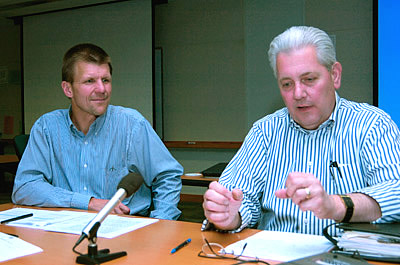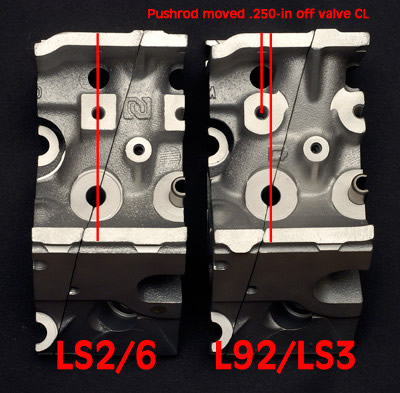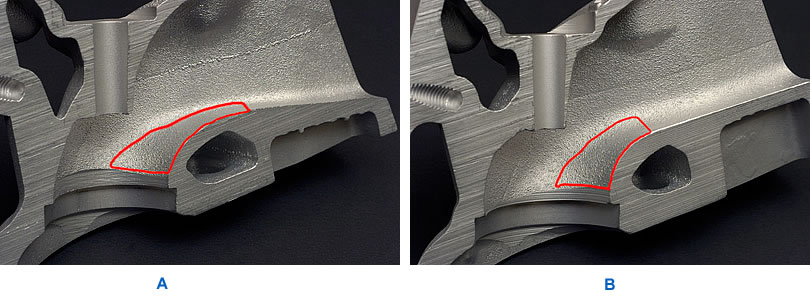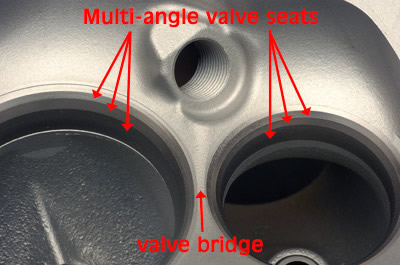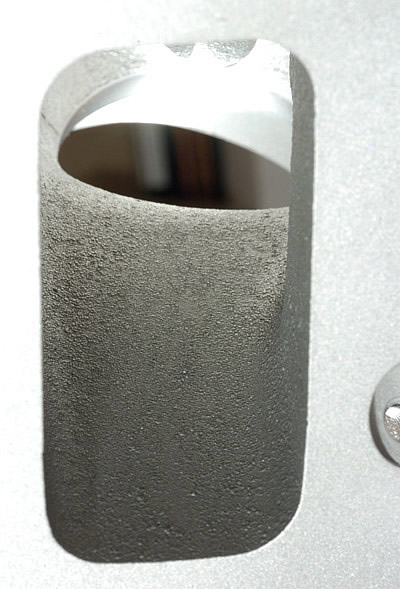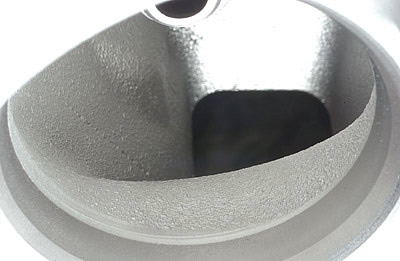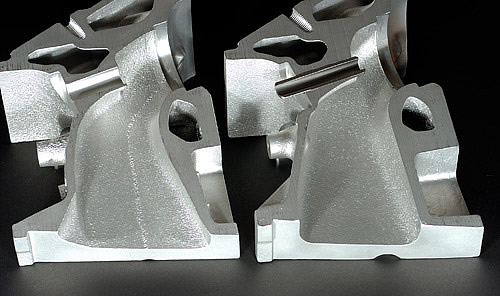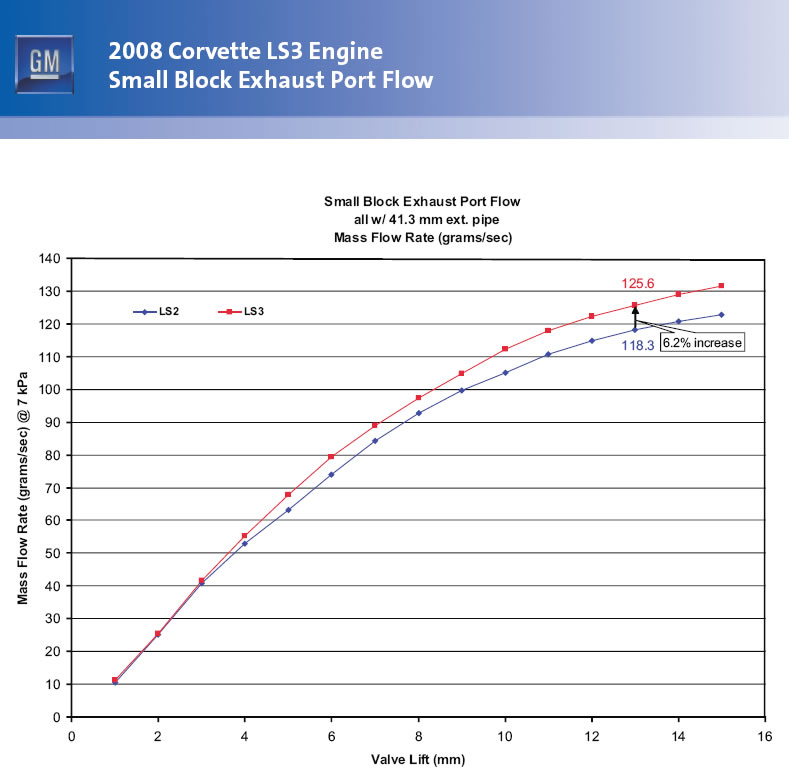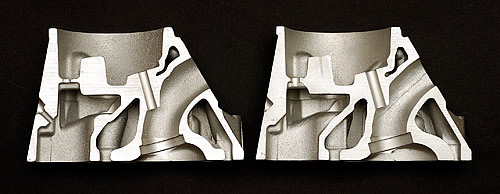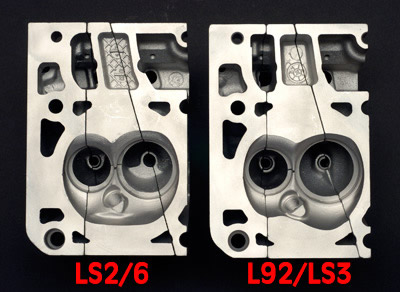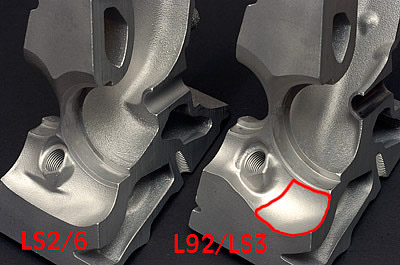Ruthless Pursuit of Power: Our In-Depth Look at the 2008 Corvette LS3 Engine - Page 4 of 6
Ruthless Pursuit of Power: 2008 Edition - Page 4 of 6
Our In-Depth Look at the New 2008 Corvette LS3 Engine
 |
 |
© 2007 by Hib Halverson
No use without permission, All Rights Reserved
The CAC staff hopes there are many more DREs like Lou Oniga working on the Corvette.
The most noticeable feature of this head is vastly different intake port location and geometry. The change was inspired by cylinder head work Mike Chapman, an under-the-radar type with a near-mythical reputation in the racing head business, did for the C5-R engine program Katech, Inc. ran for GM Racing from 1997 to 2004.
Lou Oniga takes it from here, "Based on Chapman's airflow development work, we went to a large, square intake port and did away with the 'cathedral' port we had in the older (LS1/2/6) head. The numbers say what we have now flows better than the cathedral port."
"A key enabler of this," John Rydzewski pointed out, "is moving the pushrod over. Now we had a bigger space, so we moved the port up, gave it a straight-on approach, made it larger, wider, with less turns and have less bosses in the way of the flow path. The result is a huge improvement in performance."
This new head was going on an engine having 500-cc more displacement than the one for which the previous Corvette head was designed so, not only was the shape of the ports changed dramatically but their volume was increased. Just how much larger are the ports? Lou Oniga whipped-out his little black book of head information and told us that LS2 port volumes were: 210cc for intakes and 75 cc for exhausts. LS3 intakes are 257cc and exhausts are 86cc.
To compliment larger ports, LS3s have bigger valves. The intake diameter is 55- mm (2.165") the exhaust is 40.4-mm (1.59"). Larger valves forced a 2-mm (.078") increase in valve center distance because, on this head for durability reasons, the "valve bridge"-cylinder head structure between the valves-needed to meet a minimum width whereas, with the other most recent head design for the LS7, there's no bridge at all and the valve seats are "siamesed."
In another example of aftermarket high-performance and racing processes migrating to production applications, back in 1998, GM Powertrain began making Gen 3/4 heads with multi-angle valve seats and faces. The LS3 head continues that with 30-45-60-degree multi-angle finishing on the seats and a 45° angle on the valve faces.
The "short-turn" or "short-side" radius in the intake port is the holy grail of cylinder head airflow. It is where the floor of the intake port turns downward to the area of the valve seat closest to the port entry. There are differing opinions amongst cylinder head experts about some issues, but one upon which they all agree is the importance of the short-turn radius.
"It's incredible," Oniga went on, "how much effort we put into the short-turn radius. Just a few thousandths of an inch change can affect airflow significantly-as much as 7-10 grams per second, so that's where we focused a lot of attention.
"We took the UG model of the Chapman-derived racing ports," Oniga continued, " which were fully CNC-machined, sent it to our pattern shop and they made a flow-box, based on this geometry."
"UG" is "Uni-Graphics", a high-end, 3D modeling, software application. A "flow box" is a plastic model of an individual cylinder head port from port entry or exit all the way to the valve seat.
"Then, we took these flow boxes and we flowed them, made modifications, and flowed them again, repeating this process multiple times. Next we digitized the port shapes and sent the resulting models to our foundry to manufacture a representative casting. Besides the optimized port shapes and size, metal shrinkage, manufacturing requirements, parting lines, even the coarseness of the (core) sand, all affect airflow. It took 15 iterations of the LS3 intake and exhaust ports to get the airflow to where it is, today. That was rather stressful."
Typically," John Rydzewski interjected, "we do a lot more analysis nowadays, but to get that extra few percent we sometimes have to do it the old-fashioned way."
"Our analysis tools are getting more sophisticated with each passing generation of cylinder head." Oniga continued. "Computer software tools such as GT Power, Uni-Graphics, CFD (computational fluid dynamics) and NASTRAN (software designed and licensed by NASA to private companies) are necessary tools of the development process" "but there's a human touch needed as well. We'd take development heads to the Warren airflow room. There's a gentleman working there named 'Dave Suminski.' He's a wizard. All he does is flow heads. He analyzes the flow data and makes subtle modifications to the port sets to optimize the air flow to (meet) our desired number. Dave is very good. He's from the old school of porting, polishing and flow testing. We'd take his input, then go back and make additional samples then, flow them again-fifteen times-until we finally got what we wanted. We really sweated the details, right down to the last 2 grams per second (of air flow), which are within the measurement capability of the equipment utilized.
"We wanted to create a port design that provided the flow numbers required for the desired horsepower, but that could also be reproduced in a mass production foundry on a day-to-day basis .
"We made sure casting shrink rates (of the aluminum as it cools) were as accurate as possible. We changed an aspect of casting technology, too. We use a different foundry sand on both the intake and the exhaust ports. We went to a finer silica sand so the inside of the ports are smoother. Many cylinder head experts will state that surface finish does not affect airflow. I have conclusive and repeatable data that, for this particular head, significant flow improvements came from changing to a finer sand."
The exhaust port in the new head, also, benefited from GM's ruthless pursuit of power. The port roof was raised slightly and the floor was lowered slightly which increased cross-sectional area and port volume. The short-turn radius is not as important in an exhaust port as it is in an intake, but flow still benefited somewhat from its being recontoured. To further improve flow, the valve guide boss was recontoured and the port roof just upstream of the valve was smoothed. Lastly, exhaust flow also benefitted from the finer core sand.
In spite of all that, the exhaust port didn't change near as much as did the intake because one thing GM didn't want to do was effect a practical reduction exhaust port cooling jacket volume. It was imperative that the head have good cooling around the exhaust port. Nevertheless, the port changed enough that a new exhaust manifold with revised shape at its port entries was required.
The combustion chamber in the LS3 head changed from what was used in the LS2 and LS6. The chamber is shaped differently and it's a little larger. The change in shape is the addition of a "bulge" in the chamber wall, on the opposite side of the intake valve from the short side radius.
 |
 |
